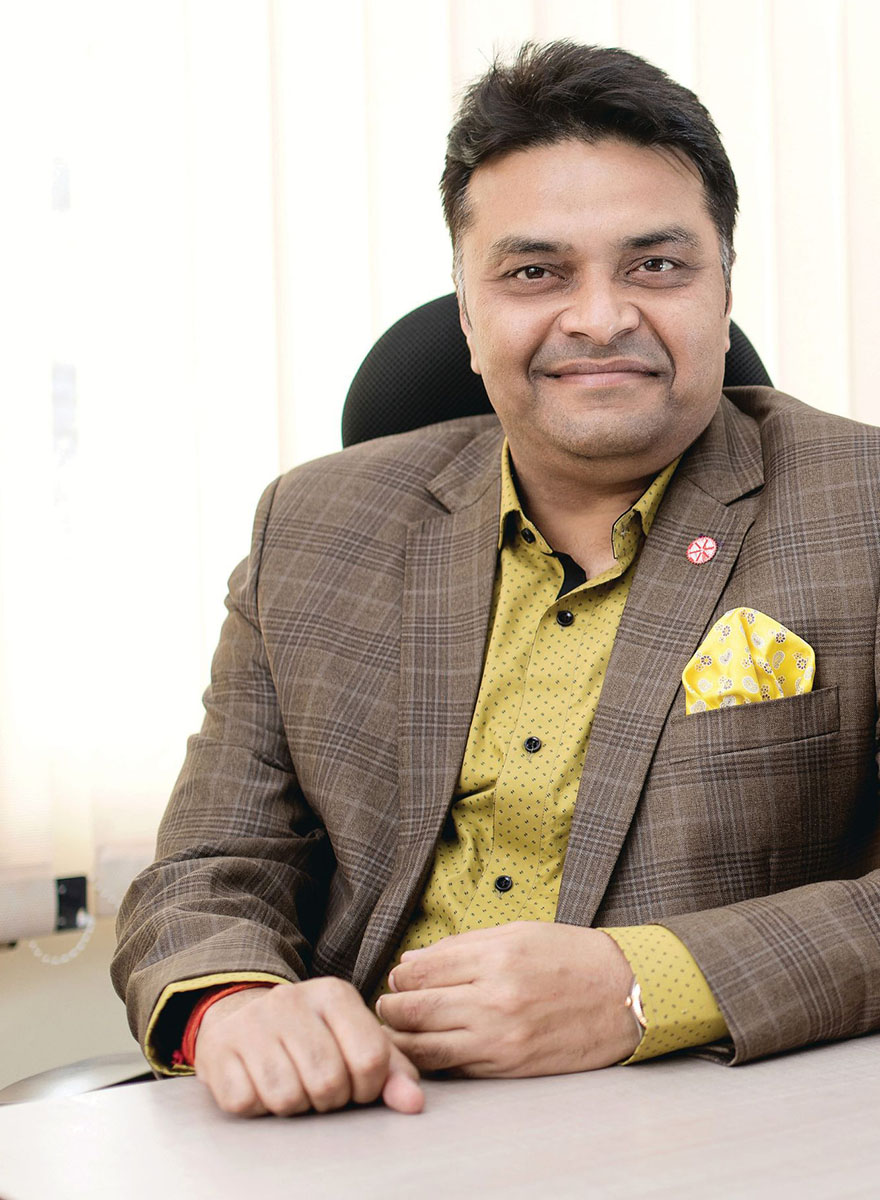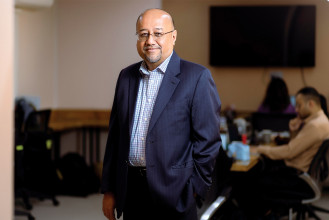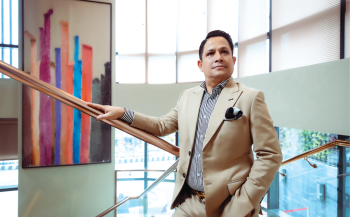
Rajesh Kumar Agrawal is Director of the Siddhartha Group with a multi-dimensional portfolio of companies that operate in various businesses like cement, minerals, banking and finance, agro processing, real estate, export, import, hospitals and hotels. The annual turnover of the group is, reportedly, more than Rs seven billion. With a business history of over six decades the group is one of the major players in corporate Nepal.
Agrawal is Executive Member of the Federation of Nepalese Chambers of Commerce and Industries and the Siddhartha Chamber of Commerce & Industry. He is also a Vice-President of the Cement Manufacturers Association, Rupandehi.
New Beginnings
Rajesh K Agrawal’s grandfather dabbled in the garment business while his father and uncles saw prospects in food grain processing. “My active involvement in the family business began in 1993. We had paddy, mustard, pulses and soybean processing industries. I looked after it till 2000,” reminisces Agrawal. By ‘looked after’ he means expanded and catapulted the family business to a new height. For example, the oil mill, which crushed 30 tons of mustard seeds, was upgraded to a new plant with a capacity for 500 tons per day, immediately translating into a revenue incline.
It is said that the true grit of a person is exhibited when he chooses to build his own path. Agrawal did not want his ambition to be contained within the tried and tested areas of his family business. “I always felt a strong pull towards the construction business. I saw a potential in it. Growth in food consumption is gradual. However, the construction sector is a completely different ball game,” states Agrawal. “Lack of proper infrastructure in the country coupled with burgeoning demand for urbanisation could only mean that the construction industry would grow,” he elaborates.
Trailblazing
At 46, Rajesh Kumar Agrawal has clocked up achievements that set new benchmarks for any business person. Buoyed by youthful bravado, he apparently caused quite a stir in the otherwise quiet Agrawal household, when he announced that he was deflecting from the traditional family business and charting a path on un-coursed waters by entering the construction business, cement to be precise. In the process, he was set to revise the family business paradigm.
Agrawal made that move in 2000. That was when Siddhartha Group - a conglomerate led by a trio of cousins began their reign over the construction industry in Nepal. They started with a cement grinding unit under the name of Siddhartha Cement which had the capacity of producing 200 TPD. In 2002, the capacity was enhanced and the plant manufactured 500 TPD. In 2007, it increased to 900 tons.
Back then, clinker, the basic raw material for cement grinding, was dominantly imported from India. “Nepal has ample limestone,” stresses Agrawal. Limestone is the basic raw material for clinker. “We have every potential to export limestone to 3-4 states in India. The reason being there is no limestone reserve in India till 1300 km from Nepal. It’s only when you reach Madhya Pradesh and Rajasthan, you get limestone. From the Nepal border, the nearest point of limestone reserve is in Satna, Madhya Pradesh. This means, we can penetrate very easily into these areas in India,” shares Agrawal in his narrative of embarking into the construction business.
With research in place, Siddhartha Group decided to install a clinker plant. The thought was germinated in 2007. “Till then two government owned cement factories (Hetauda Cement and Udaypur Cement) and a private owned cement company in Eastern Nepal (Maruti Cement) produced their own clinker. But when we analysed the plan, we hit standstill. The project was way beyond our financial capacity. The size of the project dwarfed us,” informs Agrawal.
This point also marked the beginning of three businesses coming together. The three grinding units based in Bhairahawa belonging to Murarka Group (Supreme Cement), Kedia Group (Bridge Cement) and Siddartha Group (Siddhartha Cement). The joint venture materialised the blueprint of the clinker plant in Nepal. The limestone mine of Arghakhanchi cement is in Arghakhanchi district. The three groups hold large stakes in the cement factory. There is some Indian investment in Bridge Cement and by default Arghakhanchi Cement has a minority stake held by a foreign investor.
They started work on the clinker plant from 2008 and production started from 2010. They started with 700 TPD. “At present, our production capacity is 1400 tons of clinker per day. From Jestha onwards, 2000 tons of clinker will be produced per day in our new plant which is built on an investment of Rs 5.5 billion,” states Agrawal with a touch of quiet pride.
The types of cement produced and marketed in Nepal are Ordinary Portland Cement (OPC), Portland Pozzolana Cement (PPC) and Portland Slag Cement (PSC). OPC is pure clinker and gypsum only. PPC is clinker, gypsum and Pozzolanic materials. PSC has slag, along with gypsum and clinker, which is the byproduct of steel industries. “99% market in Nepal is occupied by these three only. OPC and PPC are generally in use. Production of the type of cement primarily depends on the availability of raw materials also,” informs Agrawal and adds “We are discouraging PPC and promoting manufacture of OPC. That way, we don’t necessarily have to import materials.”
In case of the industries in Birgunj, the region majorly produces slag cement, PSC. This is due to the availability of slag from Orissa, India which connects to the dry port or up to Sirsiya.
When it comes to import of clinker, there is no denying that the country is dependent on India. “But not for very long”—if we are to trust Agrawal’s assertion. “By 2019, the country will be self-reliant in clinker production,” affirms Agrawal.
Arghakhanchi Cement
The commercial production began in December 2014. The rapidity with which Arghakhanchi Cement gained popularity is not a matter of astonishment. “The only mantra I live by is zero tolerance on quality,” stresses Agrawal. He has taken on the responsibility of Executive Director in the cement factory. “We don’t compromise on quality. We have been delivering world standard quality. We are committed to continuing with the same. When and if there is any upgrade in any area in the global cement market, we will implement it. We are even supplying upto 65 grade cement. We can attract customers—one or two times—through attractive packaging and enticing promotions, but when it comes to buildings and construction, its word of mouth that matters,” states Agrawal.
Siddhartha Cement is a purely grinding unit running with a capacity of producing 1300 tons per day. Arghakhanchi is an integrated plant which manufactures cement from limestone extracted from its own mines. Arghakhanchi only produces OPC. Siddhartha produces both OPC and PPC. Siddhartha Cement procures clinker from the market. “I am not saying it is sub-standard but since we buy the clinker, we don’t have 100% control over the quality of raw materials. Sometimes, the quality of the raw materials can be a tad bit compromised. But when it is an integrated product, there is 100% control over the quality,” remarks Agrawal when asked about the palpable differences between Siddhartha and Arghakhanchi cements.
Presently, Arghakhanchi produces 1400 TPD cement. 2500 TPD cement will be manufactured within 5-6 months. Altogether, their capacity will be one million tons per annum. “Within this financial year, the target will be met,” informs Agrawal.
If we are to save the planet, every human has to be mindful about the environment and the quality of air we breathe. “In case of the grinding unit, it does not release any chemical byproduct. Whereas, the integrated clinker based plant only emits hot air and carbon. Dust particle is within the world standard guidelines for cement industries and to stay within limits, we have installed electro-static precipitator (ESP) at the Arghakhanchi factory. Within 4-5 months, the hot air (nearly 240 degrees celsius) that is released from our plants’ chimney into the atmosphere will be tapped to produce 4megawatt electricity with the help of Waste Heat Recovery (WHR) power generation system. We are the first in Nepal to install this equipment at Arghakhanchi with an investment of almost Rs 60 crores,” informs Agrawal. This will mitigate any environmental damage.
Learnings
Rajesh Kumar Agrawal and the Siddhartha Group’s success came staggeringly fast, but the path to success was invariably punctuated with their share of risks and failures.
“I am always tempted by new projects. We established the first masaura (dehydrated preserved food) factory in Nepal. We established a cooler manufacturing factory. We also launched a project under Himali Salt to compete with Salt Trading Corporation. With Himali, it was a semi-government venture, and Salt Trading has government protection to some content, also their scale was humongous. Their presence was countrywide, and we had come to the market as a completely new and different alternative. Moreover, they had multiple products. In a way, they were more competent than us. Then there was also a conductor (required for high-voltage transmission lines) factory. We could not handle it because it was totally government supply work. It was a new business for us. We had always worked in the open market and the tendering system boggled us. To be honest, I could not handle the nature of that business,” reflects Agrawal.
Some of those projects were no short of debacle. Some moves, on his part, while well intentioned, were misguided. Reality sunk in but often late. However, it came with benefits in tow. Eventually, Agrawal realised that things were not going according to plan and he axed those businesses.
High-octane passion alone does not ensure success. In retrospect, Agrawal feels the failures set him up for later achievements. “Failure prepared me for my future ventures. There were cases of restlessness, unpreparedness, mistakes on my part in studying the market. Therefore, when I embarked on the construction business, I made sure that I wouldn’t repeat those mistakes.”
Agrawal shares that for any new business, irrespective of size, proper and detailed concept development should be practised. One must also understand supply and demand.
Siddhartha Group Today
Siddhartha Group is a product of the partnership of three cousins:Jagdish Kumar Agrawal, Krishna Murari Agrawal and Rajesh Kumar Agrawal.
The group remains prolific and on top of its game. Siddhartha Group chronicles the many brave decisions the brothers took to take their group to higher levels of achievement. So how do the three cousins divide responsibilities? “Particular sectors in every company are divided among us. Like in Arghakhnachi and Shree Steel, I am representing Siddhartha group. My cousins and their sons are looking after the other companies,” informs Agrawal.
Agrawal prepares consumers for what is to come next in the construction industry in Nepal. “I wish to inform consumers that sooner than later, competition will fire up and consumers stand to benefit largely. With healthy competition, consumers will receive better quality products at reasonable prices”.
“In business, this also means that whichever company is least adaptive to the changing times will perish. Those companies whose cost of production is lower and adaptability more will survive and eventually thrive. Those who provide the best will score. We are therefore consistently underlining the importance of quality and technology,” emphasises Agrawal.
Nepal is on the cusp of immense infrastructural transformation and Siddhartha Group will definitely play a decisive role. The important point to note is that these successes were not built on quick fixes and immediate solutions. It, somehow, does not sound hyperbolic when some cite Siddhartha Group as tomorrow’s corporate leaders.
Why Cement Is Imported
“We cannot mortgage our future to import. Clinker is imported but if we look at the custom data of the last year, hardly 5% of cement was imported from India,” informs Agrawal. There are altogether 46 cement factories in operation including two government owned factories. Despite sufficient production capacity, the country has been importing cement due to lack of certification provision for higher grade cement. Nepal Bureau of Standards and Metrology has been preparing to amend the certification provisions that were set in 1995 which is said to pave the way to certify 43 and 53 grade cement.
Only 5% of the cement market is Indian. However, with increase in the capacity building of clinker, the demand will be easily met by Nepali cement industries alone. “Moreover, Nepal imports Indian cement because public has this notion that imported products are somehow better. Some development projects demand imported cement. It is mentioned in the ADB guidelines that when they use OPC for their development projects, they must use 43 and 53 grade cement,” states Agrawal. Grading cement is not a provision under Nepal Bureau of Standards and Metrology (NBSM). Nepali cements are not graded. And graded cements are thus imported.
“We have intermittently approached the government regarding this but they have turned a deaf ear to our concerns. Despite the fact that Nepali manufacturers are competent, cement is imported from India for development projects in Nepal. Either Nepali cement should be certified as 43 or 53, whichever category grade it falls under or if we cannot have certification for Nepali manufacturers, why are cement with mentioned grade imported to Nepal? The law should treat everyone equally. Either allow us to mention grade or stop import of graded cement at the customs. If our cement falls in that grade, if our cement meets the required standard, why cannot we mention it? If NBSM desires, even the 5% import will be completely substituted by Nepali cement,” informs Agrawal.
Udaypur and Hetauda cement are the only two government owned industries competing with a host of private companies. “The two have set a quality benchmark. They are good reference. But Udaypur and Hetauda Cement Industries hardly produce 2 lakh MT per annum whereas the cement requirement of the country in this current fiscal year alone is around 80 lakh MT. The two have a long history and they have been associated as the face of cement by virtue of the fact that they were the initial cement industries in Nepal. Therefore, their names have been etched in people’s hearts and minds. There is no lacking in their product except for the insufficient quantity produced,” states Agrawal.
“Here I also want to say that the quality of cement produced by factories in Nepal which are manufacturing cement from self-produced clinker is way above or at par with Indian cements. We are talking about 43 and 53 standard cement. At Arghakhanchi, for the last two years, we are delivering cement above 60 grade.”
Challenges Of Export
“The possibility of exporting cement is not improbable. However, Nepali cement industries are infected with a few major problems. Primarily, lack of electricity. All major cement industries are largely dependent on their own generator, FO, diesel, thermal for running their plants and functioning at 50% capacity. This automatically increases production cost. Secondly, if we are to compete with India, our cost of raw material has to be brought down. At present, the cost is exponentially high. We import coal from South Africa through Haldiya and Kolkata,” informs Agrawal.
There are huge logistic costs involved. Things would ease with the establishment of Integrated Check Post (ICP) in Birgunj and Biratnagar between India and Nepal and through a well-connected railway system. “Presently, we get coal from South Africa to Haldiya, from Haldiya to Raxaul by rail, from Raxaul to Birgunj in trucks. From Birgunj to the respective factories across the country, again in trucks. Understandably, the logistic cost hits the roof. The transport cost is almost equal to the cost of the imported raw material. When and if we decide to export cement, our fear is that we might not be able to compete with Indian cement in terms of pricing.”
Shree Steel
“Shree Steel has Nepal’s largest and most advanced steel plant. It is of world standard quality. I even went to Japan to study steel manufacturing. Japan experiences the most number of earthquakes in the world. As a result, they have done more research and have the most advanced technology. In Nepal, after the 2015 earthquake, importance is being given to construction materials,” informs Agrawal on his latest project. Shree Steels has a capacity of 300,000 tons per annum.
Besides Business
I have decentralised a lot of power to my subordinates. No matter how gigantic Siddhartha Group grows to become, Agrawal wants to ensure time for his family. “We usually take all our meals together,” he says. The family of five: Rajesh Agrawal, his mother, wife and two adult children go on two or three annual holidays together.
Leaving A Footprint
Agrawal has long been a staunch defender of hard work. “There are no shortcuts in life and in business. Honesty, hard work, sincerity and innovation will catapult any business,” he says. He has inculcated this philosophy in his children as well. He knows too well that he is also teaching his children the culture of happiness.
According to him, the parameter of success is not the wealth he has accumulated. “What I want to be remembered as is someone who created employment and helped transform million of lives. This is what I want to be remembered for,” he concludes.



-1767340083.jpg)

